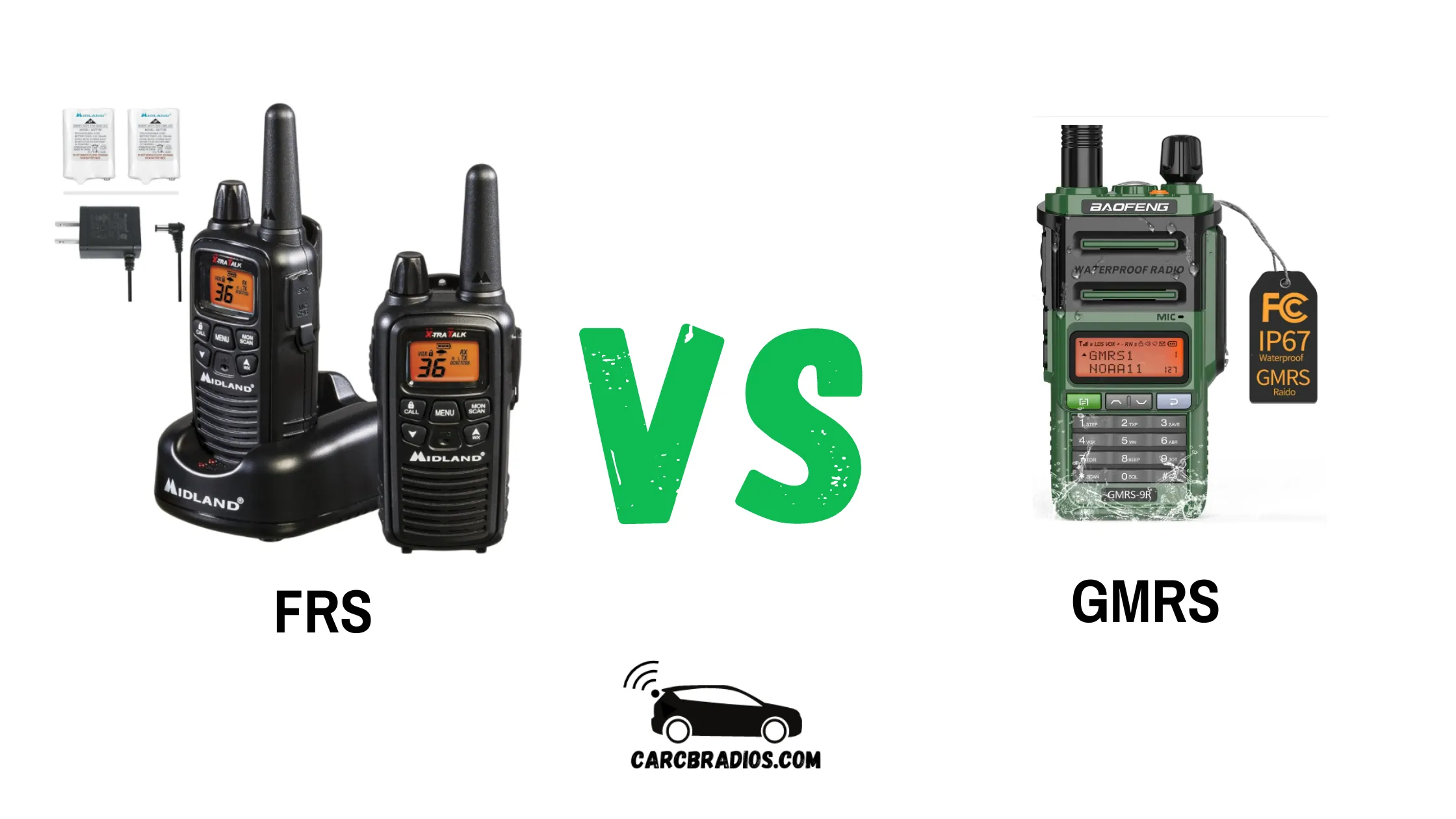By: Jeremy Neisser
Family Radio Service (FRS) and General Mobile Radio Service (GMRS) are two types of radio communication systems that are often compared for personal or business use. They serve similar purposes but are governed by different regulations and technical specifications.
FRS is a low-power and short-range communication system that typically requires no license to operate, making it an ideal choice for families and recreational activities. It is designed for easy access and simplicity, with limited channels and privacy codes.
GMRS, in contrast, provides a more robust service with greater power, which in turn extends its range of communication. This makes it suitable for businesses or individuals requiring more reliable and expansive connectivity. A GMRS license is required by the Federal Communications Commission (FCC) to operate these devices legally.
The licensing process is straightforward and, once obtained, covers the licensee's immediate family as well. GMRS-compatible devices often allow for the use of repeater stations to further increase their operational range.
Key Takeaways
- FRS is license-free and suitable for short-range, personal communication.
- GMRS requires a license and caters to individuals and businesses needing extended range.
- GMRS devices can use repeaters to significantly improve communication distance.

Understanding FRS and GMRS
In this section, we explore the development, regulatory aspects, and distinctive characteristics of Family Radio Service (FRS) and General Mobile Radio Service (GMRS).
History and Development
FRS was established in the United States in 1996 to provide an unlicensed, short-distance, two-way radio communication option for families and recreational activities. GMRS, on the other hand, has been in use since the 1940s and was initially created for business communications before becoming available for consumer use.
Licensing and Regulation
While FRS does not require users to obtain a license to operate, GMRS users must obtain a license from the Federal Communications Commission (FCC). To legally operate a GMRS system, an individual must be at least 18 years old and must not represent a foreign government.
Key Features and Differences
The key differences between FRS and GMRS are in power limits and channels available:
FRS
- Maximum power of 2 watts
- Access to 22 channels (Channels 8-14 are exclusively FRS)
GMRS
- Higher power limits (Up to 50 watts)
- Access to 22 channels plus 8 additional repeater channels
FRS radios are typically more limited in range than GMRS radios because of the lower power and lack of repeater use. On the other hand, GMRS radios can achieve greater distances due to higher power and the use of repeaters that extend the range of communication.
Technical Specifications
Within this section, I will outline the technical specifications of FRS (Family Radio Service) and GMRS (General Mobile Radio Service) radios. These details are crucial when comparing the capabilities and regulations of these two types of radio services.
Frequency Ranges
FRS and GMRS radios operate on a system of channels within specific frequency bands designated by the FCC:
- FRS: I have access to 22 channels, ranging from 462.5625 MHz to 467.7125 MHz.
- GMRS: I use the same 22 channels as FRS, in addition to 8 additional repeater channels, bringing my range from 462.5500 MHz to 467.7250 MHz.
Power Output
The power output of the radios plays a significant role in their performance:
- FRS: My radios have a maximum power output of 2 watts on channels 1 to 7 and 15 to 22, and 0.5 watts on channels 8 to 14.
- GMRS: I operate at higher power levels, with up to 50 watts on channels 1 to 7 and 15 to 22.
Range and Performance
The effective communication range of FRS and GMRS radios can vary based on several factors:
- FRS: With my 2 watt maximum power, I can typically reach up to 1-2 miles under most conditions.
- GMRS: I am capable of extended range, sometimes exceeding 5 miles, especially when using repeater channels.
Equipment and Usage
FRS (Family Radio Service) and GMRS (General Mobile Radio Service) radios cater to different communication needs and follow specific regulatory restrictions. It's essential to understand the equipment designed for each service and how it can be utilized effectively.
You may be interested in:
Typical Devices
FRS radios:
- Limited to 2 watts of power.
- No license required for operation.
GMRS radios:
- Up to 50 watts of power for mobile or base station radios.
- FCC license needed to operate.
Channel Sharing and Privacy Codes
Both FRS and GMRS share 22 channels; however:
- FRS is accessible on all 22 channels.
- GMRS can use an additional 8 repeater channels for extended range.
Privacy Codes:
- Serve to reduce interference.
- Do not provide secure communication.
Accessories and Add-Ons
FRS and GMRS Compatible Accessories:
- External microphones
- Earpieces for discrete listening
- Antennas for improved range on GMRS devices
GMRS Specific Add-Ons:
- Higher-gain antennas for base stations
- Power amplifiers (subject to FCC rules)
Applications of FRS and GMRS
Family Radio Service (FRS) and General Mobile Radio Service (GMRS) radios serve distinct purposes depending on the user's needs and the context in which they're being used. I'll detail their specific applications below.
Personal and Recessional Use
I use FRS when engaging in activities like hiking or camping with family and friends because it doesn’t require a license and is simple to use. FRS radios are ideal for short-distance communication up to a range of typically 0.5 to 1.5 miles, making them perfect for outdoor leisure activities or coordinating in crowded locations such as theme parks or shopping malls.
GMRS, on the other hand, offers extended range, typically 1 to 2 miles without the need for a repeater, and can reach up to 5 miles or more when using one. I find them suitable for organized events or extended outdoor adventures where reliable communication over greater distances is required.
Commercial and Professional Use
Although FRS is not intended for commercial use, GMRS can be employed in a professional setting. I often observe businesses utilizing GMRS radios for operational communications. With the appropriate licensing, GMRS serves as a reliable tool for coordinating tasks among staff in various industries, such as event coordination, construction sites, and facility management, where clear communication over moderate distances is essential.
Emergency and Public Safety Use
In emergency situations, both FRS and GMRS radios prove valuable. I notice that members of neighborhood watch groups and emergency preparedness organizations frequently use these devices due to their ability to operate independently of cell networks, which can be vital when other systems fail or are overloaded.
Specifically, GMRS is beneficial for its ability to connect to repeater stations, thus significantly extending the communication range. This feature is particularly useful for coordinating community response in extensive emergencies or across challenging terrain.
Legal Considerations
When using FRS and GMRS radios, I must comply with specific Federal Communications Commission (FCC) regulations. Any misuse can lead to penalties, including fines or legal action.
FCC Regulations
FRS (Family Radio Service) radios are governed by the FCC under 47 CFR Part 95, which sets limits on power output and prohibits the use of detachable antennas. I need no license to operate FRS radios as they have a maximum power of 2 watts.
On the other hand, GMRS (General Mobile Radio Service) requires a license from the FCC for operation. GMRS can have a maximum power output of 50 watts, and certain GMRS radios may use detachable antennas, which can extend their range. Licensing involves a fee and the requirement to provide my personal details to the FCC.
Penalties for Misuse
The penalties for operating GMRS without a license, or for using either service in a way that violates the FCC rules, can be severe. The FCC may impose monetary penalties—fines can reach up to $19,246 per violation as of the latest information. If I operate a GMRS radio without the proper license, I risk these fines. Repeated or egregious violations can even result in criminal charges, leading to higher fines and possible imprisonment.
For compliance, maintaining a current knowledge of the FCC's evolving regulations is essential.
Advantages and Disadvantages
When assessing Family Radio Service (FRS) and General Mobile Radio Service (GMRS), it's important to consider how they stack up against similar services and what their respective benefits and drawbacks are. Each service offers unique features that may be better suited for certain users and uses.
Comparison with Other Radio Services
FRS and GMRS are both radio services that are often compared to Citizens Band (CB) and other two-way radio services for personal or commercial use. FRS does not require a license and is best for short-range, casual communications with low-powered handheld radios. GMRS provides for longer-range communication and can operate on higher power levels, but it requires users to obtain a license from the Federal Communications Commission (FCC).
FRS:
- License: Not required
- Power: Up to 2 watts
- Range: Shorter, usually less than a mile
GMRS:
- License: Required
- Power: Up to 50 watts
- Range: Longer, often several miles
Pros and Cons of FRS
Pros:
- Ease of Use: No license is needed, making it accessible for everyone.
- Cost: Generally, FRS radios are less expensive than GMRS radios.
Cons:
- Limited Range: The maximum power of 2 watts limits the range of communication.
- Overcrowding: Channels may become congested, as everyone can use FRS.
Pros and Cons of GMRS
Pros:
- Extended Range: Higher power limits offer a broader communication range.
- Expandability: Options for external antennas and repeaters enhance coverage.
Cons:
- Licensing: Acquiring a license may be a barrier for some users.
- Cost: Typically, GMRS radios and the necessary equipment come at a higher price point.
Frequently Asked Questions
In this section, I'll address common inquiries regarding the usage and characteristics of FRS and GMRS radios.
What are the key differences between GMRS and FRS radios?
FRS (Family Radio Service) radios are limited to 2 watts of power and don't require a license, whereas GMRS (General Mobile Radio Service) radios can be used with up to 50 watts of power and require a license from the FCC.
Is a license required to operate FRS or GMRS radios?
A license is not required for FRS radios; however, operating GMRS radios without the necessary FCC license is against the law.
How do the ranges of FRS radios compare to those of GMRS radios?
FRS radios typically have shorter ranges, often less than two miles under normal conditions, due to lower power limits. GMRS radios can exceed that range significantly, especially with higher power and the use of repeaters.
What are the specific frequencies allocated to FRS and GMRS channels?
FRS is allocated to 14 channels between 462 and 467 MHz in the UHF band. GMRS covers the same FRS frequencies and includes additional channels up to 467 MHz.
Can GMRS radios communicate with FRS radios on the same channels?
Yes, GMRS radios can communicate with FRS radios on shared channels, provided FRS rules (such as power restrictions) are followed while communicating.
Which type of radio is best suited for personal use, FRS or GMRS?
For most personal uses where immediate short-range communication is required, such as a hiking trip or family outing, FRS radios are adequate and more practical due to no licensing requirement. GMRS radios are better suited for users needing longer range and broader capabilities.

Hi & Welcome!
My name is Jeremy and I have been an avid car nut for many year. My first car was an 1987 Honda CRX. I put in my first Kenwood stereo, amp, 2 10" JLs and a CB Radio in it and have been an avid user of CBs and car radios for years. I'll do my best to share my tips, information and thoughts to help you with whatever question you might have, ABOUT ME
After I graduated from High School, I worked 5 years are Radio Shack and 3 years at Circuit City answering questions and helping customers with various electronics questions.


